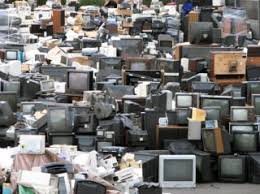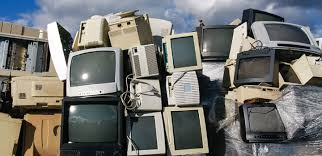When an electronic product is abandoned after its usable life has passed, e-waste, or electronic garbage, is produced. E-waste is produced in enormous quantities due to the quick development of technology and our society’s emphasis on consumption.
When an electronic product is abandoned after its usable life has passed, e-waste, or electronic garbage, is produced. E-waste is produced in enormous quantities due to the quick development of technology and our society’s emphasis on consumption.
Electronic garbage, sometimes known as e-waste, refers to outdated electrical or electronic equipment. E-waste includes used electronics that are intended for recycling through material recovery, refurbishment, reuse, resale, or disposal. E-waste processing done informally in developing nations can have a negative impact on human health and pollute the environment.
CPUs are an example of an electronic trash component that may include hazardous substances including lead, cadmium, beryllium, or flame retardants that have been brominated. E-waste recycling and disposal could pose a serious risk to the health of workers and the communities they live in.
It is essential to decrease e-waste by just purchasing what you need, reusing devices that are still in good working order, and recycling electronics once their useful lives have passed. The same E-Waste Recycling Fee that was applied to your purchase of “covered electronic equipment” goes toward funding recycling events.
Use the online materials exchange LACoMAX to sell any useable electronics you have, or give them to your preferred charity. Broken electronics that can be fixed are sometimes accepted by charities. Additionally, you can visit the US Environmental Protection Agency to find programs close to you or get in touch with your city’s recycling coordinator.
If your electronics are no longer functional, check our calendar to learn when the local HHW/E-Waste Roundup will be taking place.
You can also call your city for any special programs or collection events that might be available to you, or you can use a permanent collection facility or a collection event run by the City of LA.
Recycling at all Green Locations
▪ Headquarters for National E-Waste Recycling 7397 Doig Drive Garden Grove, California 92841
▪ Aliso Viejo, California 92656 (714) 782-1485 Global Corporate Headquarters 1 Polaris Way STE 110
▪ Regional Office for N. California 1650 Bell Avenue #100 Sacramento, CA 95691 (916) 287-7650
▪ The Willard’s regional office is located at 1455 Pennsylvania Avenue NW, Suite 400, Washington, DC 20004; phone: (202) 875-8661
▪ 1033 Corporate Square Drive, St. Louis, MO 63132 (314) 392-0222, Midwest Regional Headquarters
All Green Electronics Recycling is pleased to organize R2 Certified e-waste recycling drives for the benefit of localities, communities, schools, non-profits, and charities.
Using the map or the list of E-waste Collection Points, locate the locations closest to you.
Utilize the map or the list of E-waste Collection Points to locate the closest E-waste Collection Points to you. You can use your map to locate your local electronic waste collection site regardless of where you are in the world. You can also leave your electronic waste on the side of the road for simple pickups on the designated days
Where to Recycle
▪ ALBA has placed e-waste recycling bins across Singapore’s public spaces, including town centers, malls, government buildings, residents’ committee centers, community centers, supermarkets, and retail establishments.

▪ Public can dispose of their e-waste1 via the shop’s in-store collection service (through a container or over-the-counter collection), with or without purchasing any goods or services from the retailer.
Read Also : Complete List of Recyclable Wastes (Waste Recyclables)
▪ Residents can drop off their electronic garbage at quarterly e-waste collection drives held in residential areas (the schedule is available on the ALBA website or ALBA STEP UP mobile app).
▪ Free one-for-one take back of regulated consumer goods of the same sort that aren’t sought by merchants after delivery (e.g. free takeback of unwanted washing machine upon delivery of a new one by the retailer)
▪ The disposal of large things is a service offered by town councils.
▪ ALBA offers doorstep collection for a fee; for pricing information, see ALBA’s website or ALBA STEP UP mobile app.
▪ Drop off at the ALBA depot in Singapore, at 20 Tuas Loop, 637350
E-waste is increasing, making it necessary to put in place efficient electronics recycling programs. E-waste is now the world’s fastest-growing waste stream, with an estimated 48.5 million metric tons of waste in 2018. This is according to research from the World Economic Forum. Based on historical patterns, it appears that by 2023, there may have been generated 61 million metric tons.
Even in this day and age, massive IT equipment, telephones, and computers that are no longer in use are frequently thrown away.
In 25 states across the US, recycling of electronics is now mandated. Since the majority of these rules provide that the manufacturer must cover the cost of recycling, most businesses are free to ship their outdated equipment back to the manufacturer for recycling.
Businesses in California, on the other hand, pay an Advanced Recycling Fee (ARF) to support the recycling of used IT equipment. However, no federal laws are used to regulate electronic recycling.
We implore you to participate in this effort because we must all do our share to protect the environment. There may be laws limiting the disposal of E-Waste in some municipalities or towns. When it comes to underutilized or retired networking equipment, speaking with a reseller like Dedicated Networks to assess the equipment could result in savings for you.
Importance of e-waste
(1) Preventing the Negative Effects of Toxic Materials: Adequate processing is necessary to stop the release of toxic materials into the environment because outdated electrical equipment contains dangerous substances like lead, mercury, cadmium, and chromium, as well as other heavy metals and potentially hazardous chemical flame retardants.
(2) Stop the Transport of Hazardous Waste Internationally: Concern has been raised about the free movement of e-waste to nations where harmful releases have put locals’ health at danger due to cheap labor and poor recycling practices. Therefore, it is intended to avoid this through ethical e-waste recycling.
(3) Numerous electrical equipment components rely on pricey raw ingredients to function. Recycling outdated equipment results in energy savings. It also implies that fewer natural resources are required to produce new technology.
(4) Reusing outdated equipment keeps it out of landfills, which reduces e-waste. Additionally, it conserves the resources that were previously used for recycling. By offering refurbished equipment at a lower price or by using it as parts to repair broken equipment, repurposing equipment also helps people in your community. Therefore, if at all feasible, sell your outdated equipment so that it might be given the chance to live longer.

